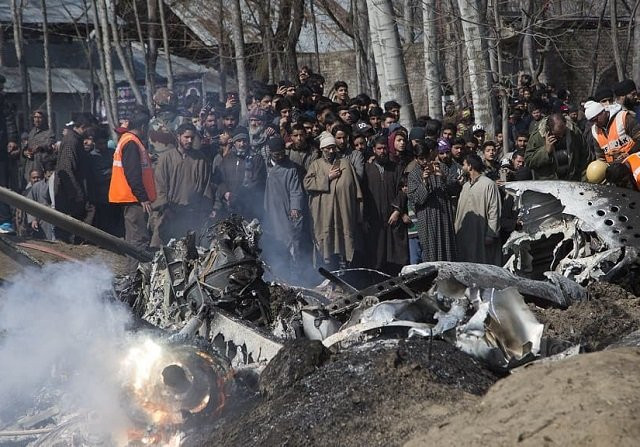‘Friendly fire’ possible reason behind Indian Air Force chopper crash
According to investigators, six IAF officials and a citizen were killed in Budgam crash on February 27

Six Indian Air Force officials and a citizen were killed in the Budgam crash on February 27. PHOTO COURTESY: FIRST POST/INDIA
The Russian-made chopper had crashed near Srinagar on the same day Pakistan Air Force (PAF) downed two IAF fighter jets killing one pilot while capturing the other in a dogfight. The helicopter was crashed in an open field near Garend Kalaan village in Budgam at around 10am, according to the Indian officials.
Pakistan’s chief military spokesperson Major General Asif Ghafoor had also mentioned the incident in a news conference as the country’s armed forces struck back following unprovoked Indian aggression a day earlier. Pakistan, however, denied playing a role in the chopper’s crash.
Foreign journalist doubts India's narrative on F-16 use
According to a defence source, all possible angles would be probed with regard to the crash, including that of friendly fire, keeping in mind the fact that air defence systems near Srinagar were operational at the time of crash, The Economic Times reported.
Senior Indian military officials, at the time of the incident, had claimed that the chopper went down after developing a “technical snag” despite the fact that Mi-17 is considered as one of the sturdiest choppers in service across the world and does not usually develop technical snags.
“A court of inquiry has been ordered and we cannot speculate on the reason behind the crash before it submits its report,” an IAF officer was quoted by the Indian daily as saying.
Ball is now in India’s court: DG ISPR
However, eyewitnesses had reportedly heard a loud explosion in the air just before the helicopter went down, indicating the possibility of some external event causing the crash. Besides, both command and control systems were functioning under extreme pressure at the time as a ‘fog of war’ prevailed, the report added.
The Indian air defence systems, mostly controlled by the IAF, purportedly have inbuilt safeguards to identify and distinguish between friend and foe and if friendly fire is found to be the reason behind the crash, “this would mean breach in multiple layers of safeguards”, according to the report.
It may be mentioned here that the families of those killed in the crash have been promised answers within ten to 15 days.
This article originally appeared in The Economic Times



















COMMENTS
Comments are moderated and generally will be posted if they are on-topic and not abusive.
For more information, please see our Comments FAQ